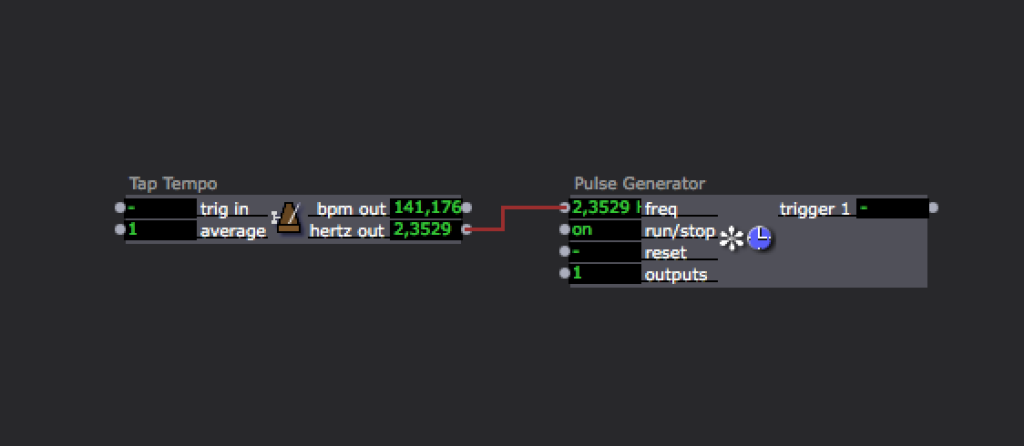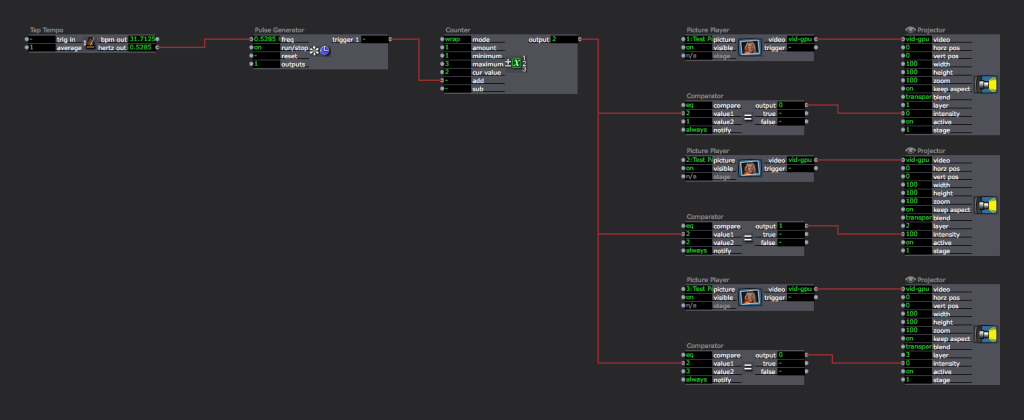triggering sequential pictures
-
Have a simple problem that my brain is not figuring at the moment. I have three images of a gun that need to appear in succession, each moving a simple animation forward. It's easy to trigger between two images simply making one the MIN and one the MAX and toggling between the two of them. Adding the third doesn't work since toggle just goes back and forth between the two. I've tried using the sequential trigger to turn one off as the other one is turned on to replace it, but there is a drop out of image when this occurs. I would simple make a short movie of the animation but I need to trigger the changes to live music, which shifts slightly each night. Thanks!
-
You could use the counter actor. If the images are not in foll already numbered in order, in the media, you could add the selector actor.

There is even a tap actor, you could use to match the timing.
Good night and good luck
Dill -
Ok, sorry. It's to late and I probably didn't read through the end...
The problem is, that the images are probably to big to load them instantly fast enough in a cycle. Do it the other way around:

Values of the selector and the router actors are mutable. The moment you connect the video output of the picture player to one of the selector inputs, it changes them to video.
Best
Delil
-
@DillTheKraut 's way is much simpler, but you could also do it in a couple different ways (all accomplishing the same thing).
(Note: Make sure that the Tap Tempo actor's "herz out" output parameter is connected to the Pulse Generator's "freq" input parameter. @DillTheKraut had the "bpm out" connected to the "freq", which results in crazy-fast frequencies.)
(Note: You may want to play around with the "average" input parameter of the Tap Tempo actor, or skip the Tap Tempo and Pulse Generator actors entirely and trigger the Counter actor manually by yourself if the tempo of the music changes too much for the process to be automated.)


Make sure to pay attention to the parameters that are initialized.
Counter: "cur value"
- Set to initialize at "3" (the end of the sequence) because that means that the first time the Counter's "add" is triggered, it will take you to the beginning of your sequence.
- This is a general trick to remember whenever you're using a Counter actor
- If you do not initialize this value, then you cannot guarantee that your sequence will start in the right place when you come back to the Scene a second time.
Comparators: "value1"
- Since the Counter actor's output only updates when the "add" or "subtract" parameters are triggered, initializing the "cur value" parameter on the Counter actor does not have any effect on making sure that your Comparator actors have the right value for the beginning of the sequence.
- Thus you need to initialize all of the Comparator actors at "1" (the beginning of your sequence).
- Since the "notify" parameter of the Comparators is set to "always", when you enter the Scene, the all the Comparators have their "value1" parameters initialized at 1, meaning:
- The first Comparator compares 1 to 1 (true = 1 = on) and turns on the first Projector
- The second and third Comparators compare 1 to 2 (false = 0 = off) and 1 to 3 (false = 0 = off) and turn the second and third Projectors off.
Projectors: "active"
- Just to be extra safe, I initialized the first Projector's "active" parameter as "on" and the second and third Projector's "active" parameters as "off"
Best wishes,
Woland
- Set to initialize at "3" (the end of the sequence) because that means that the first time the Counter's "add" is triggered, it will take you to the beginning of your sequence.
-
Thanks to both of you. Yes, I'll be working with live music and the tempo won't be able to be automated, but great to know it's there. I love getting different routes to accomplish the same end. This will also get me back into the Comparator Actor, which I haven't used much yet.